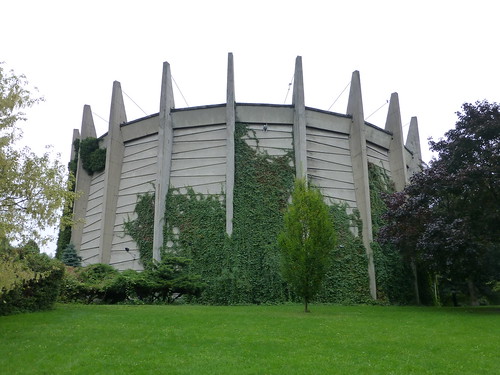Panorama Racławicka Posted by Kasia on Sep 22, 2010 in Culture
Every year Panorama Racławicka attracts many tourists who come to Wrocław on business or leisure. The building is situated only 10 minutes walk from the city center, next to the National Museum and the Museum of Architecture. Tours and headphones in various languages are available. It is worth stopping there if you are in Wrocław. Let me give you a little bit more info about it and hopefully after this blog you will be interested in visiting the place in person.
The Racławice Panorama (Polish: Panorama Racławicka) is a monumental (15 × 114 meter) panoramic painting depicting the Battle of Racławice, during the Kościuszko Uprising. It is currently located in Wrocław, Poland. The painting is one of only a few preserved relics of a genre of 19th century mass culture, and the oldest in Poland. The panorama stands in a circular fashion and, with the viewer in the center, presents different scenes at various viewing angles. A special kind of perspective used in the painting and additional effects (lighting, artificial terrain) create a feeling of reality.
The idea came from the painter Jan Styka in Lwów who invited the renowned battle-painter Wojciech Kossak to participate in the project.
The project was conceived as a patriotic manifestation commemorating the 100th anniversary of the victorious Battle of Racławice, a famous episode of the Kościuszko Insurrection, a heroic but in the end fallen attempt to defend Polish independence. The battle was fought on April 4, 1794 between the insurrectionist force of regulars and peasant volunteers (bearing homemade scythes) under Kościuszko (1746 – 1817) himself and the Russian army commanded by General Alexander Tormasov. For the nation which had lost its independence, the memory of this glorious victory was particularly important.
The National Exhibition, organized in Lwów in 1894, offered an excellent opportunity to realize Styka’s idea. Canvas, woven to order, was bought in Brussels, the specially built rotunda’s iron structure (designed by Ludwik Ramułt) in Vienna. The rotunda, located in Stryjski Park in Lwów, was ready in July 1893. The huge panorama painting was executed within 9 months, between August 1893 and May 1894. The official opening was on June 5, 1894. Since the very beginning, Panorama of the Battle of Racławice attracted enormous attention and brought crowds of tourists to Lwów.
After World War II, the painting was brought to Wrocław along with a part of the collection of the Ossoliński Institution. As under the Communist regime the subject was considered politically sensitive, the efforts to have the canvas restored and exhibited, undertaken by successive Volunteer Committees, were successful only after August 1980. Reopened on June 14, 1985, the major attraction of the old Lwów has immediately become the main tourist attraction of Wrocław. Here, contemporary viewers have an opportunity to participate in a unique illusionist spectacle. Among the many guests who have visited the panorama are Archduke Charles, Duke of Teschen, Pope John Paul II; Beatrix, the Queen of the Netherlands; and Czesław Miłosz, winner of the 1980 Nobel Prize for Literature.
Here is a little glimpse of what you can expect at the Museum:
Do następnego razu! (Till next time…)

Build vocabulary, practice pronunciation, and more with Transparent Language Online. Available anytime, anywhere, on any device.
About the Author: Kasia
My name is Kasia Scontsas. I grew near Lublin, Poland and moved to Warsaw to study International Business. I have passion for languages: any languages! Currently I live in New Hampshire. I enjoy skiing, kayaking, biking and paddle boarding. My husband speaks a little Polish, but our daughters are fluent in it! I wanted to make sure that they can communicate with their Polish relatives in our native language. Teaching them Polish since they were born was the best thing I could have given them! I have been writing about learning Polish language and culture for Transparent Language’s Polish Blog since 2010.





Comments:
gab:
It doesn’t links to the topc but I was wondering how do you say Kosciuszko?
(Koshchushko?) Your blog is wonderful anyway. Jestem Wegierka and it’s really
interesting to read about these things, and knowing more about Poland.
Gabi